Understanding and Leading Change: Drivers, Impacts, and Strategies | Desklib
VerifiedAdded on 2023/01/09
|13
|3279
|96
AI Summary
This document discusses the drivers of change, their impacts on leadership, teams, and individuals, and strategies to minimize negative impacts. It also evaluates organizational responses to change and provides recommendations for effective planning.
Contribute Materials
Your contribution can guide someone’s learning journey. Share your
documents today.
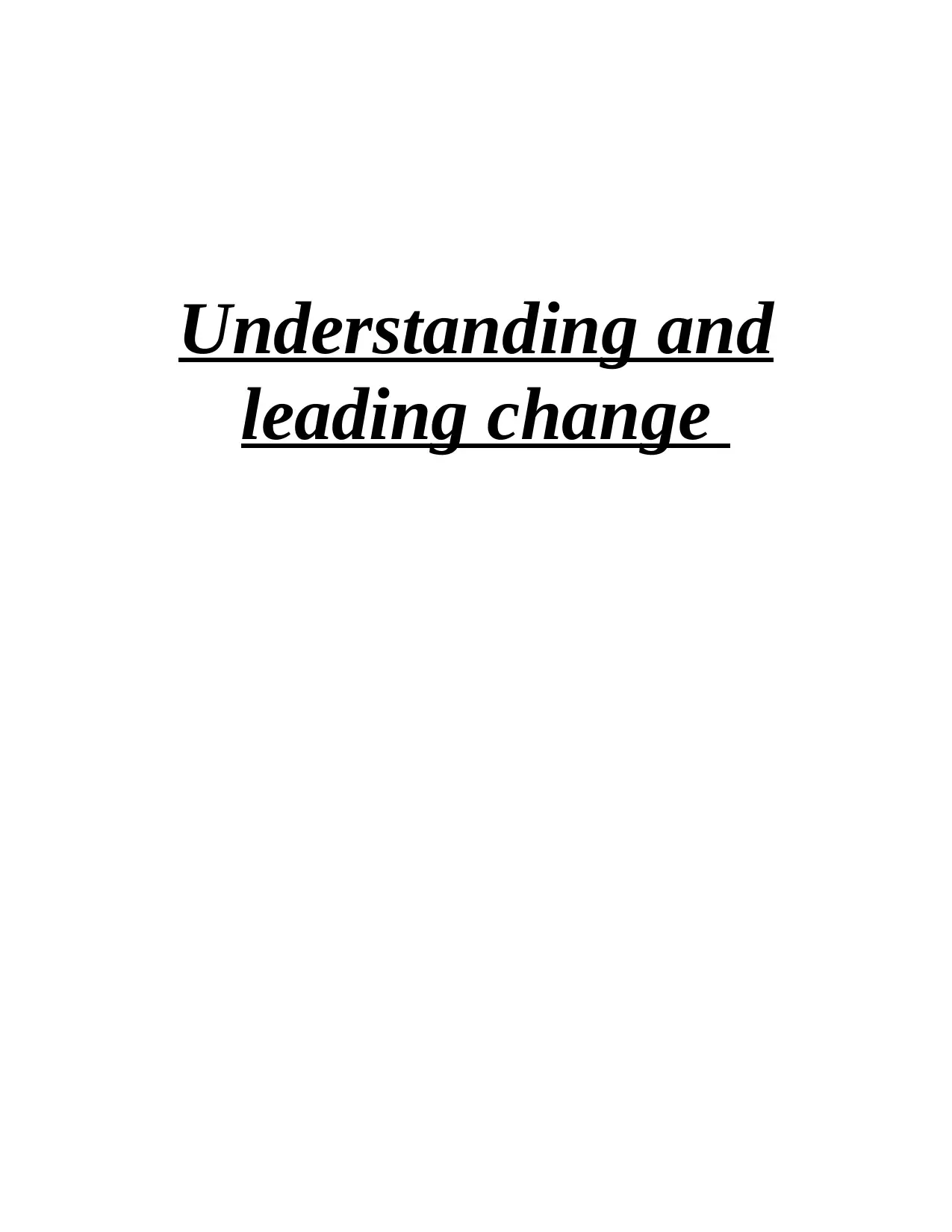
Understanding and
leading change
leading change
Secure Best Marks with AI Grader
Need help grading? Try our AI Grader for instant feedback on your assignments.
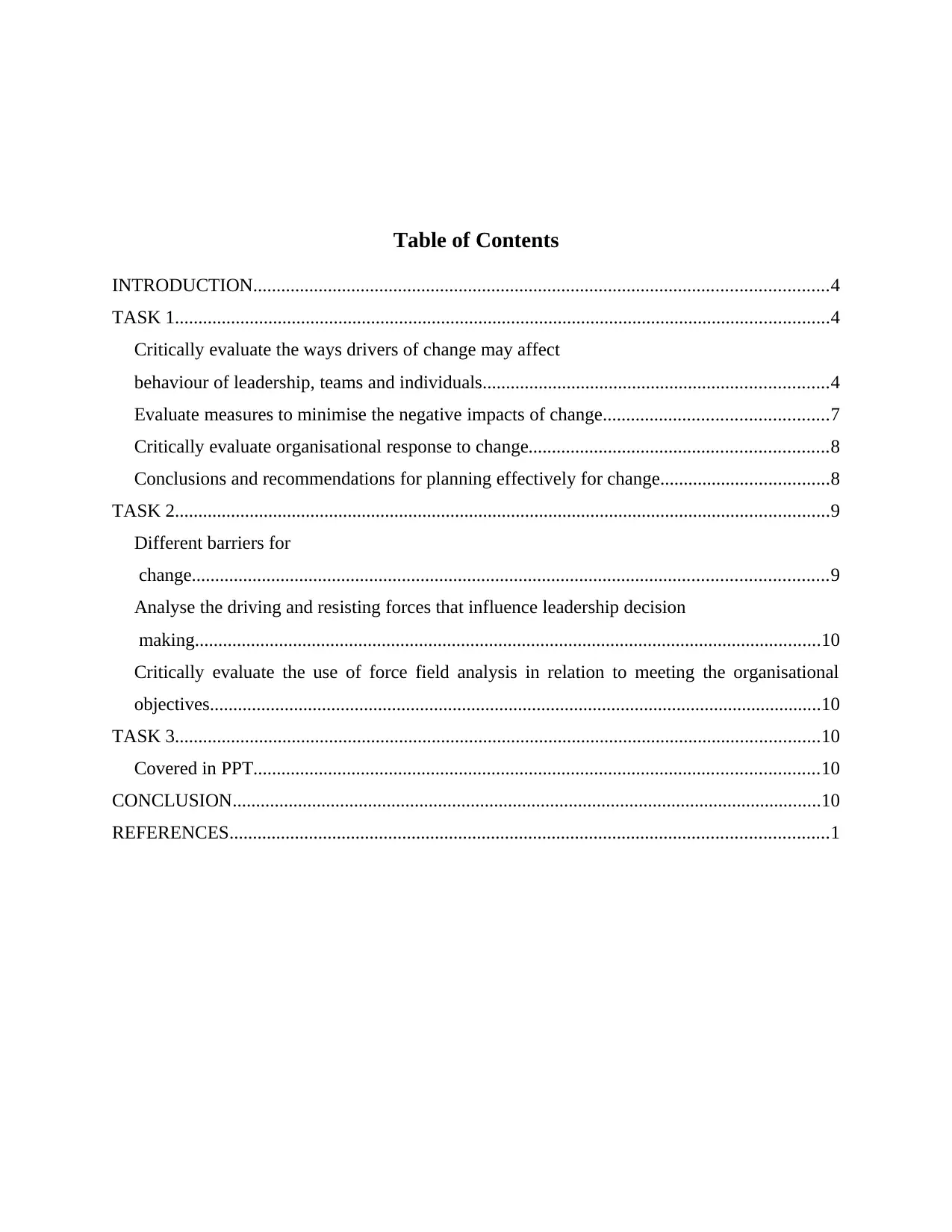
Table of Contents
INTRODUCTION...........................................................................................................................4
TASK 1............................................................................................................................................4
Critically evaluate the ways drivers of change may affect
behaviour of leadership, teams and individuals..........................................................................4
Evaluate measures to minimise the negative impacts of change................................................7
Critically evaluate organisational response to change................................................................8
Conclusions and recommendations for planning effectively for change....................................8
TASK 2............................................................................................................................................9
Different barriers for
change........................................................................................................................................9
Analyse the driving and resisting forces that influence leadership decision
making......................................................................................................................................10
Critically evaluate the use of force field analysis in relation to meeting the organisational
objectives...................................................................................................................................10
TASK 3..........................................................................................................................................10
Covered in PPT.........................................................................................................................10
CONCLUSION..............................................................................................................................10
REFERENCES................................................................................................................................1
INTRODUCTION...........................................................................................................................4
TASK 1............................................................................................................................................4
Critically evaluate the ways drivers of change may affect
behaviour of leadership, teams and individuals..........................................................................4
Evaluate measures to minimise the negative impacts of change................................................7
Critically evaluate organisational response to change................................................................8
Conclusions and recommendations for planning effectively for change....................................8
TASK 2............................................................................................................................................9
Different barriers for
change........................................................................................................................................9
Analyse the driving and resisting forces that influence leadership decision
making......................................................................................................................................10
Critically evaluate the use of force field analysis in relation to meeting the organisational
objectives...................................................................................................................................10
TASK 3..........................................................................................................................................10
Covered in PPT.........................................................................................................................10
CONCLUSION..............................................................................................................................10
REFERENCES................................................................................................................................1

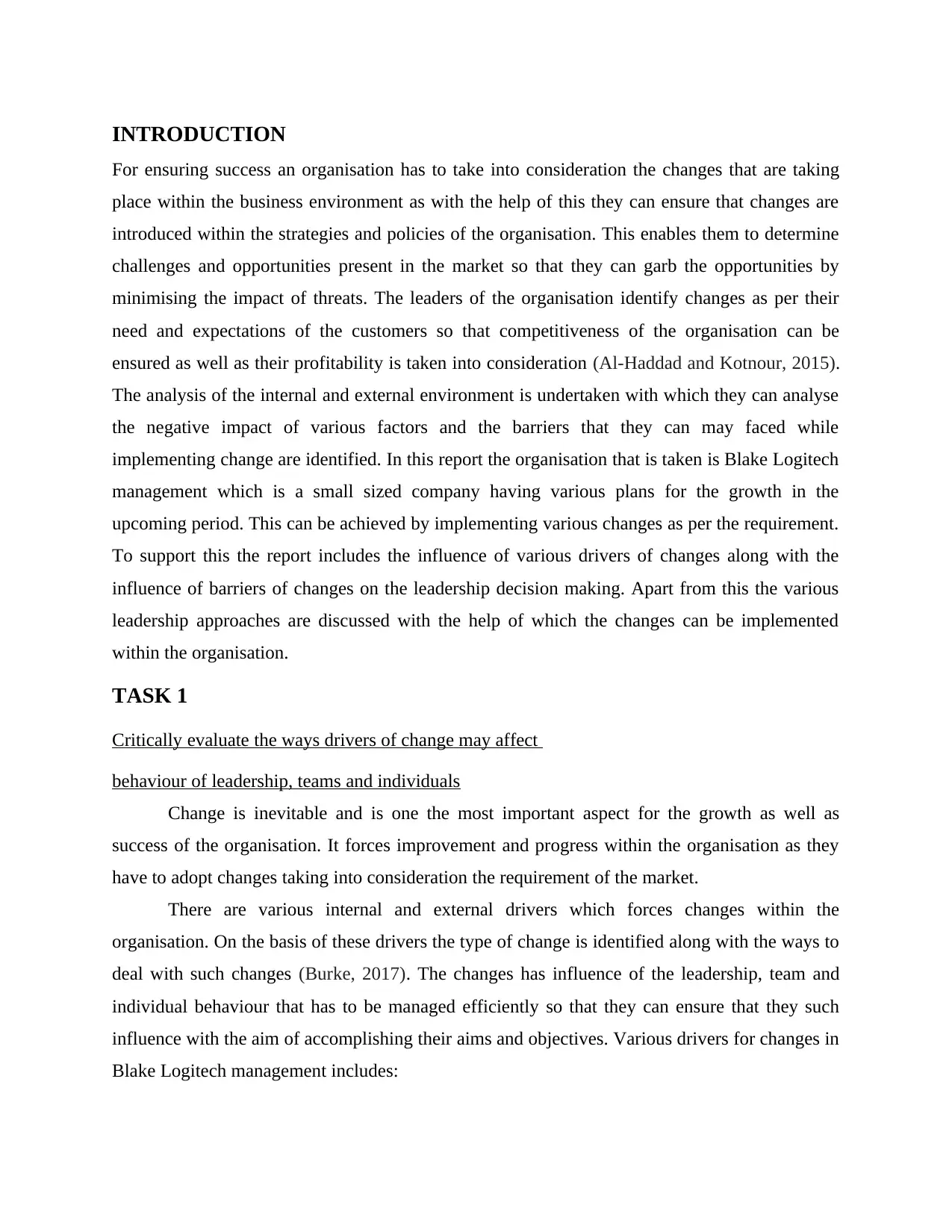
INTRODUCTION
For ensuring success an organisation has to take into consideration the changes that are taking
place within the business environment as with the help of this they can ensure that changes are
introduced within the strategies and policies of the organisation. This enables them to determine
challenges and opportunities present in the market so that they can garb the opportunities by
minimising the impact of threats. The leaders of the organisation identify changes as per their
need and expectations of the customers so that competitiveness of the organisation can be
ensured as well as their profitability is taken into consideration (Al-Haddad and Kotnour, 2015).
The analysis of the internal and external environment is undertaken with which they can analyse
the negative impact of various factors and the barriers that they can may faced while
implementing change are identified. In this report the organisation that is taken is Blake Logitech
management which is a small sized company having various plans for the growth in the
upcoming period. This can be achieved by implementing various changes as per the requirement.
To support this the report includes the influence of various drivers of changes along with the
influence of barriers of changes on the leadership decision making. Apart from this the various
leadership approaches are discussed with the help of which the changes can be implemented
within the organisation.
TASK 1
Critically evaluate the ways drivers of change may affect
behaviour of leadership, teams and individuals
Change is inevitable and is one the most important aspect for the growth as well as
success of the organisation. It forces improvement and progress within the organisation as they
have to adopt changes taking into consideration the requirement of the market.
There are various internal and external drivers which forces changes within the
organisation. On the basis of these drivers the type of change is identified along with the ways to
deal with such changes (Burke, 2017). The changes has influence of the leadership, team and
individual behaviour that has to be managed efficiently so that they can ensure that they such
influence with the aim of accomplishing their aims and objectives. Various drivers for changes in
Blake Logitech management includes:
For ensuring success an organisation has to take into consideration the changes that are taking
place within the business environment as with the help of this they can ensure that changes are
introduced within the strategies and policies of the organisation. This enables them to determine
challenges and opportunities present in the market so that they can garb the opportunities by
minimising the impact of threats. The leaders of the organisation identify changes as per their
need and expectations of the customers so that competitiveness of the organisation can be
ensured as well as their profitability is taken into consideration (Al-Haddad and Kotnour, 2015).
The analysis of the internal and external environment is undertaken with which they can analyse
the negative impact of various factors and the barriers that they can may faced while
implementing change are identified. In this report the organisation that is taken is Blake Logitech
management which is a small sized company having various plans for the growth in the
upcoming period. This can be achieved by implementing various changes as per the requirement.
To support this the report includes the influence of various drivers of changes along with the
influence of barriers of changes on the leadership decision making. Apart from this the various
leadership approaches are discussed with the help of which the changes can be implemented
within the organisation.
TASK 1
Critically evaluate the ways drivers of change may affect
behaviour of leadership, teams and individuals
Change is inevitable and is one the most important aspect for the growth as well as
success of the organisation. It forces improvement and progress within the organisation as they
have to adopt changes taking into consideration the requirement of the market.
There are various internal and external drivers which forces changes within the
organisation. On the basis of these drivers the type of change is identified along with the ways to
deal with such changes (Burke, 2017). The changes has influence of the leadership, team and
individual behaviour that has to be managed efficiently so that they can ensure that they such
influence with the aim of accomplishing their aims and objectives. Various drivers for changes in
Blake Logitech management includes:
Secure Best Marks with AI Grader
Need help grading? Try our AI Grader for instant feedback on your assignments.
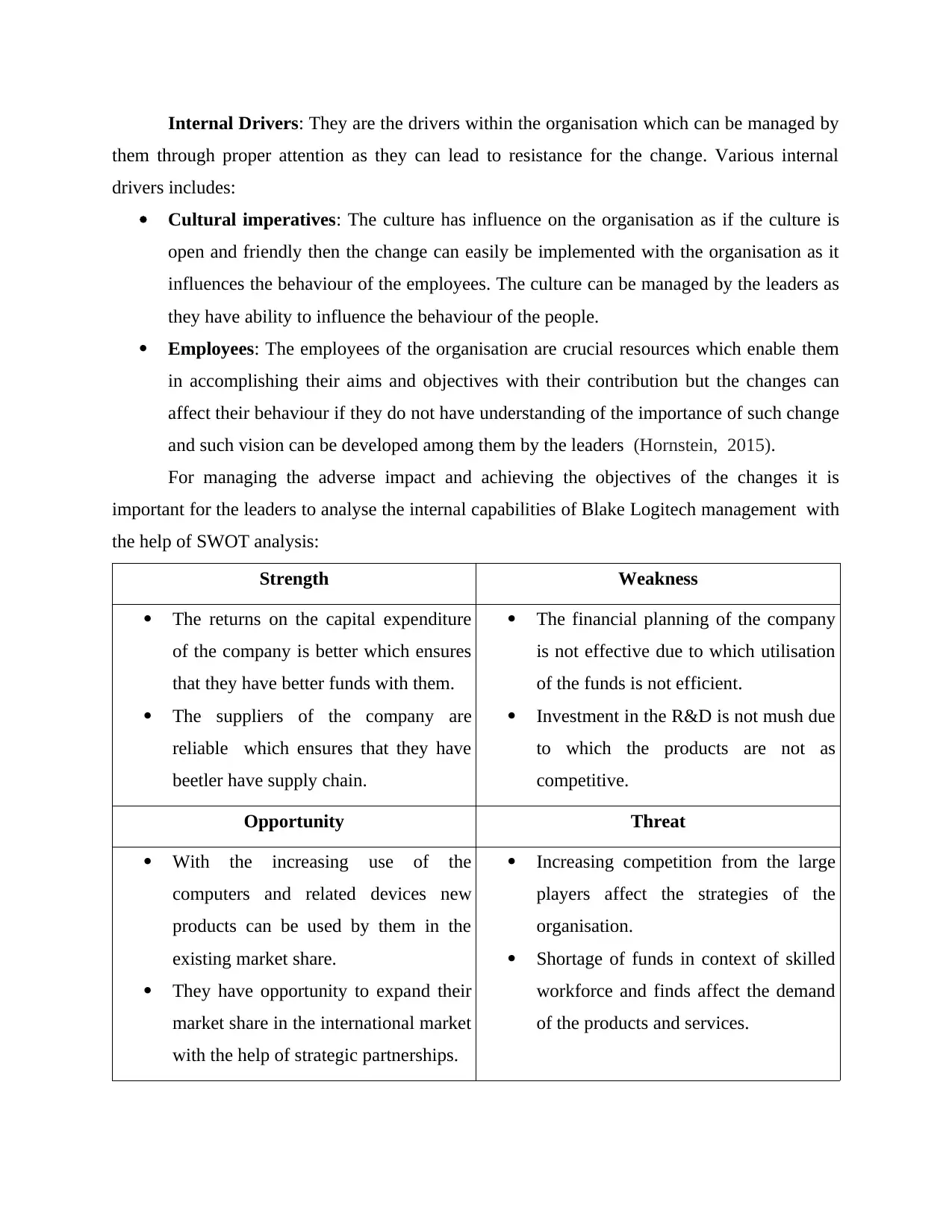
Internal Drivers: They are the drivers within the organisation which can be managed by
them through proper attention as they can lead to resistance for the change. Various internal
drivers includes:
Cultural imperatives: The culture has influence on the organisation as if the culture is
open and friendly then the change can easily be implemented with the organisation as it
influences the behaviour of the employees. The culture can be managed by the leaders as
they have ability to influence the behaviour of the people.
Employees: The employees of the organisation are crucial resources which enable them
in accomplishing their aims and objectives with their contribution but the changes can
affect their behaviour if they do not have understanding of the importance of such change
and such vision can be developed among them by the leaders (Hornstein, 2015).
For managing the adverse impact and achieving the objectives of the changes it is
important for the leaders to analyse the internal capabilities of Blake Logitech management with
the help of SWOT analysis:
Strength Weakness
The returns on the capital expenditure
of the company is better which ensures
that they have better funds with them.
The suppliers of the company are
reliable which ensures that they have
beetler have supply chain.
The financial planning of the company
is not effective due to which utilisation
of the funds is not efficient.
Investment in the R&D is not mush due
to which the products are not as
competitive.
Opportunity Threat
With the increasing use of the
computers and related devices new
products can be used by them in the
existing market share.
They have opportunity to expand their
market share in the international market
with the help of strategic partnerships.
Increasing competition from the large
players affect the strategies of the
organisation.
Shortage of funds in context of skilled
workforce and finds affect the demand
of the products and services.
them through proper attention as they can lead to resistance for the change. Various internal
drivers includes:
Cultural imperatives: The culture has influence on the organisation as if the culture is
open and friendly then the change can easily be implemented with the organisation as it
influences the behaviour of the employees. The culture can be managed by the leaders as
they have ability to influence the behaviour of the people.
Employees: The employees of the organisation are crucial resources which enable them
in accomplishing their aims and objectives with their contribution but the changes can
affect their behaviour if they do not have understanding of the importance of such change
and such vision can be developed among them by the leaders (Hornstein, 2015).
For managing the adverse impact and achieving the objectives of the changes it is
important for the leaders to analyse the internal capabilities of Blake Logitech management with
the help of SWOT analysis:
Strength Weakness
The returns on the capital expenditure
of the company is better which ensures
that they have better funds with them.
The suppliers of the company are
reliable which ensures that they have
beetler have supply chain.
The financial planning of the company
is not effective due to which utilisation
of the funds is not efficient.
Investment in the R&D is not mush due
to which the products are not as
competitive.
Opportunity Threat
With the increasing use of the
computers and related devices new
products can be used by them in the
existing market share.
They have opportunity to expand their
market share in the international market
with the help of strategic partnerships.
Increasing competition from the large
players affect the strategies of the
organisation.
Shortage of funds in context of skilled
workforce and finds affect the demand
of the products and services.
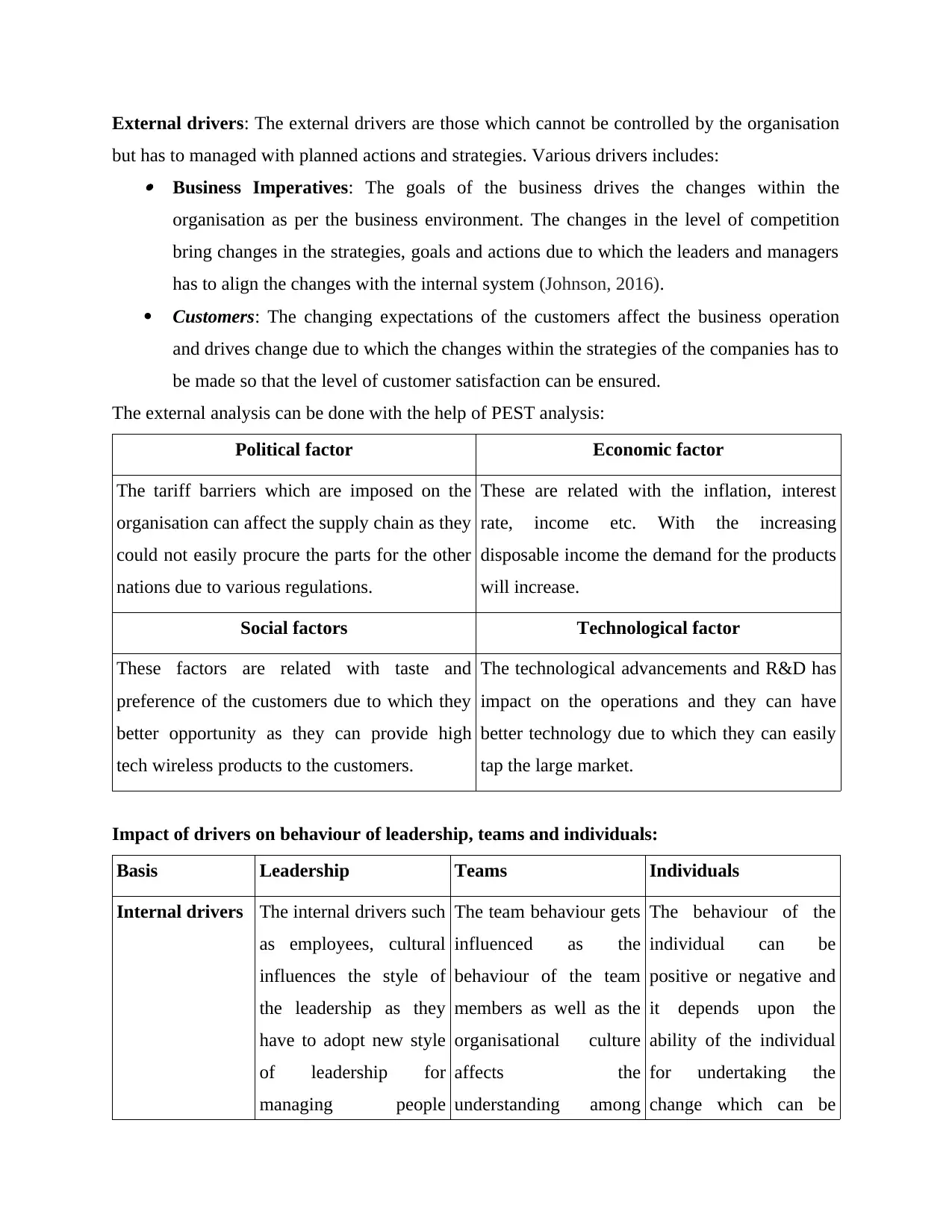
External drivers: The external drivers are those which cannot be controlled by the organisation
but has to managed with planned actions and strategies. Various drivers includes: Business Imperatives: The goals of the business drives the changes within the
organisation as per the business environment. The changes in the level of competition
bring changes in the strategies, goals and actions due to which the leaders and managers
has to align the changes with the internal system (Johnson, 2016).
Customers: The changing expectations of the customers affect the business operation
and drives change due to which the changes within the strategies of the companies has to
be made so that the level of customer satisfaction can be ensured.
The external analysis can be done with the help of PEST analysis:
Political factor Economic factor
The tariff barriers which are imposed on the
organisation can affect the supply chain as they
could not easily procure the parts for the other
nations due to various regulations.
These are related with the inflation, interest
rate, income etc. With the increasing
disposable income the demand for the products
will increase.
Social factors Technological factor
These factors are related with taste and
preference of the customers due to which they
better opportunity as they can provide high
tech wireless products to the customers.
The technological advancements and R&D has
impact on the operations and they can have
better technology due to which they can easily
tap the large market.
Impact of drivers on behaviour of leadership, teams and individuals:
Basis Leadership Teams Individuals
Internal drivers The internal drivers such
as employees, cultural
influences the style of
the leadership as they
have to adopt new style
of leadership for
managing people
The team behaviour gets
influenced as the
behaviour of the team
members as well as the
organisational culture
affects the
understanding among
The behaviour of the
individual can be
positive or negative and
it depends upon the
ability of the individual
for undertaking the
change which can be
but has to managed with planned actions and strategies. Various drivers includes: Business Imperatives: The goals of the business drives the changes within the
organisation as per the business environment. The changes in the level of competition
bring changes in the strategies, goals and actions due to which the leaders and managers
has to align the changes with the internal system (Johnson, 2016).
Customers: The changing expectations of the customers affect the business operation
and drives change due to which the changes within the strategies of the companies has to
be made so that the level of customer satisfaction can be ensured.
The external analysis can be done with the help of PEST analysis:
Political factor Economic factor
The tariff barriers which are imposed on the
organisation can affect the supply chain as they
could not easily procure the parts for the other
nations due to various regulations.
These are related with the inflation, interest
rate, income etc. With the increasing
disposable income the demand for the products
will increase.
Social factors Technological factor
These factors are related with taste and
preference of the customers due to which they
better opportunity as they can provide high
tech wireless products to the customers.
The technological advancements and R&D has
impact on the operations and they can have
better technology due to which they can easily
tap the large market.
Impact of drivers on behaviour of leadership, teams and individuals:
Basis Leadership Teams Individuals
Internal drivers The internal drivers such
as employees, cultural
influences the style of
the leadership as they
have to adopt new style
of leadership for
managing people
The team behaviour gets
influenced as the
behaviour of the team
members as well as the
organisational culture
affects the
understanding among
The behaviour of the
individual can be
positive or negative and
it depends upon the
ability of the individual
for undertaking the
change which can be
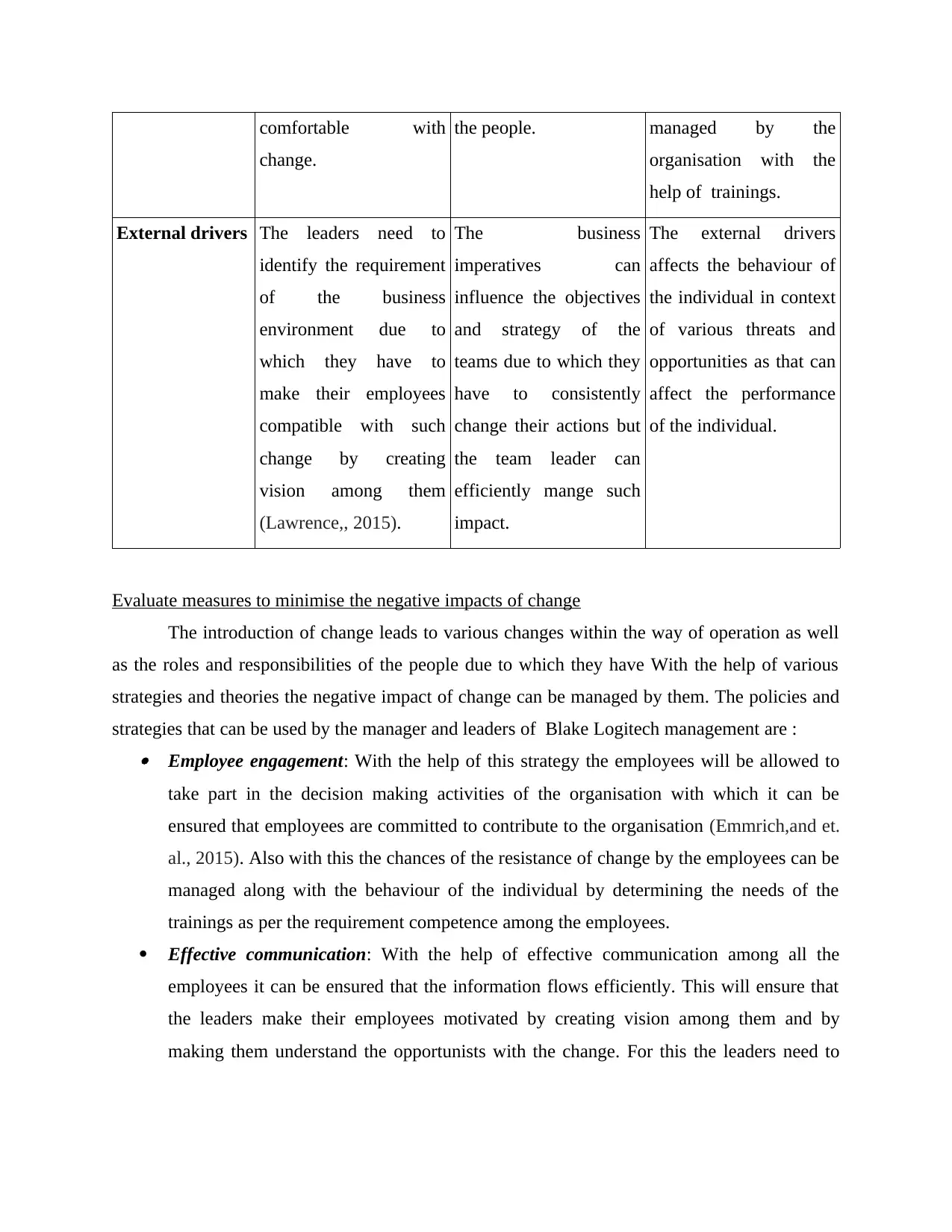
comfortable with
change.
the people. managed by the
organisation with the
help of trainings.
External drivers The leaders need to
identify the requirement
of the business
environment due to
which they have to
make their employees
compatible with such
change by creating
vision among them
(Lawrence,, 2015).
The business
imperatives can
influence the objectives
and strategy of the
teams due to which they
have to consistently
change their actions but
the team leader can
efficiently mange such
impact.
The external drivers
affects the behaviour of
the individual in context
of various threats and
opportunities as that can
affect the performance
of the individual.
Evaluate measures to minimise the negative impacts of change
The introduction of change leads to various changes within the way of operation as well
as the roles and responsibilities of the people due to which they have With the help of various
strategies and theories the negative impact of change can be managed by them. The policies and
strategies that can be used by the manager and leaders of Blake Logitech management are : Employee engagement: With the help of this strategy the employees will be allowed to
take part in the decision making activities of the organisation with which it can be
ensured that employees are committed to contribute to the organisation (Emmrich,and et.
al., 2015). Also with this the chances of the resistance of change by the employees can be
managed along with the behaviour of the individual by determining the needs of the
trainings as per the requirement competence among the employees.
Effective communication: With the help of effective communication among all the
employees it can be ensured that the information flows efficiently. This will ensure that
the leaders make their employees motivated by creating vision among them and by
making them understand the opportunists with the change. For this the leaders need to
change.
the people. managed by the
organisation with the
help of trainings.
External drivers The leaders need to
identify the requirement
of the business
environment due to
which they have to
make their employees
compatible with such
change by creating
vision among them
(Lawrence,, 2015).
The business
imperatives can
influence the objectives
and strategy of the
teams due to which they
have to consistently
change their actions but
the team leader can
efficiently mange such
impact.
The external drivers
affects the behaviour of
the individual in context
of various threats and
opportunities as that can
affect the performance
of the individual.
Evaluate measures to minimise the negative impacts of change
The introduction of change leads to various changes within the way of operation as well
as the roles and responsibilities of the people due to which they have With the help of various
strategies and theories the negative impact of change can be managed by them. The policies and
strategies that can be used by the manager and leaders of Blake Logitech management are : Employee engagement: With the help of this strategy the employees will be allowed to
take part in the decision making activities of the organisation with which it can be
ensured that employees are committed to contribute to the organisation (Emmrich,and et.
al., 2015). Also with this the chances of the resistance of change by the employees can be
managed along with the behaviour of the individual by determining the needs of the
trainings as per the requirement competence among the employees.
Effective communication: With the help of effective communication among all the
employees it can be ensured that the information flows efficiently. This will ensure that
the leaders make their employees motivated by creating vision among them and by
making them understand the opportunists with the change. For this the leaders need to
Paraphrase This Document
Need a fresh take? Get an instant paraphrase of this document with our AI Paraphraser
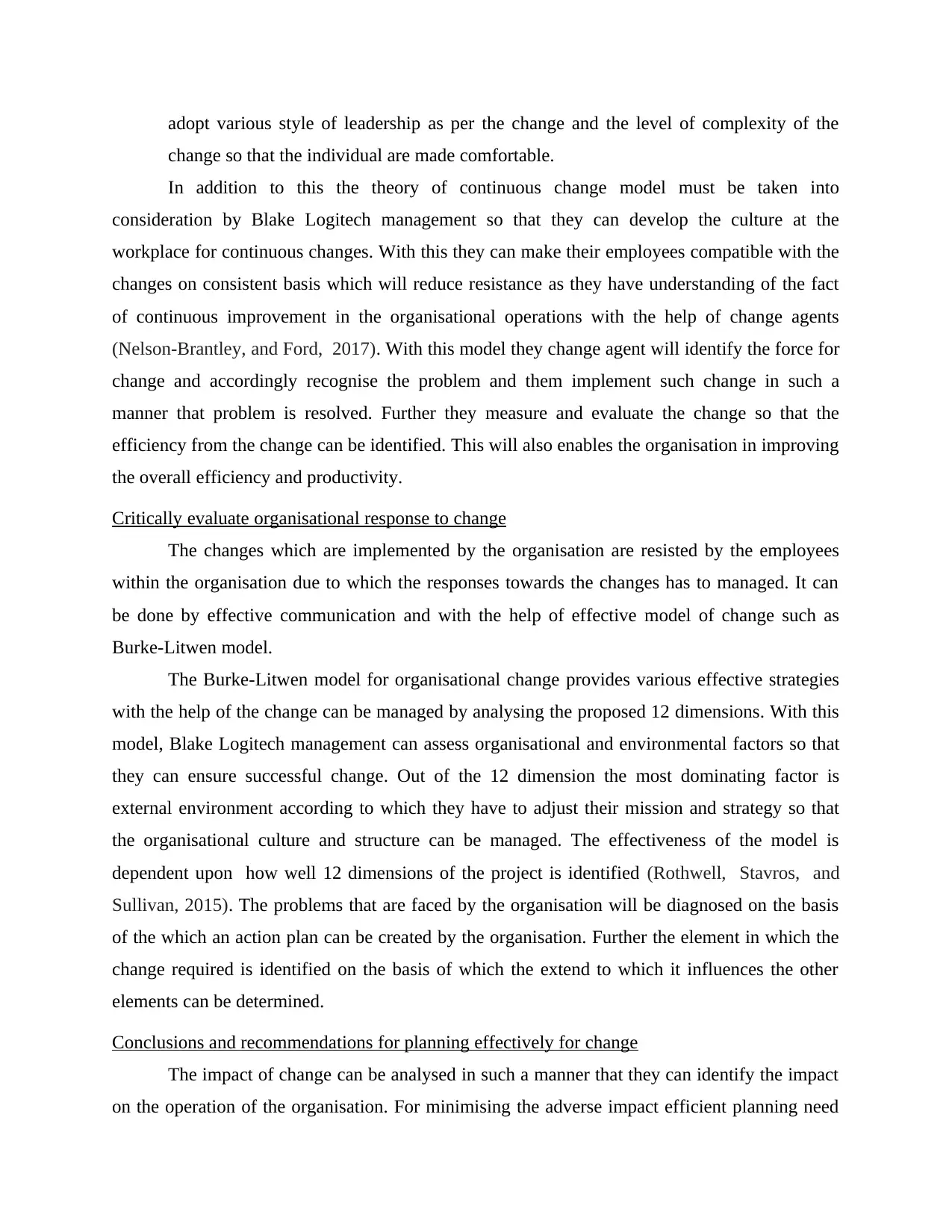
adopt various style of leadership as per the change and the level of complexity of the
change so that the individual are made comfortable.
In addition to this the theory of continuous change model must be taken into
consideration by Blake Logitech management so that they can develop the culture at the
workplace for continuous changes. With this they can make their employees compatible with the
changes on consistent basis which will reduce resistance as they have understanding of the fact
of continuous improvement in the organisational operations with the help of change agents
(Nelson‐Brantley, and Ford, 2017). With this model they change agent will identify the force for
change and accordingly recognise the problem and them implement such change in such a
manner that problem is resolved. Further they measure and evaluate the change so that the
efficiency from the change can be identified. This will also enables the organisation in improving
the overall efficiency and productivity.
Critically evaluate organisational response to change
The changes which are implemented by the organisation are resisted by the employees
within the organisation due to which the responses towards the changes has to managed. It can
be done by effective communication and with the help of effective model of change such as
Burke-Litwen model.
The Burke-Litwen model for organisational change provides various effective strategies
with the help of the change can be managed by analysing the proposed 12 dimensions. With this
model, Blake Logitech management can assess organisational and environmental factors so that
they can ensure successful change. Out of the 12 dimension the most dominating factor is
external environment according to which they have to adjust their mission and strategy so that
the organisational culture and structure can be managed. The effectiveness of the model is
dependent upon how well 12 dimensions of the project is identified (Rothwell, Stavros, and
Sullivan, 2015). The problems that are faced by the organisation will be diagnosed on the basis
of the which an action plan can be created by the organisation. Further the element in which the
change required is identified on the basis of which the extend to which it influences the other
elements can be determined.
Conclusions and recommendations for planning effectively for change
The impact of change can be analysed in such a manner that they can identify the impact
on the operation of the organisation. For minimising the adverse impact efficient planning need
change so that the individual are made comfortable.
In addition to this the theory of continuous change model must be taken into
consideration by Blake Logitech management so that they can develop the culture at the
workplace for continuous changes. With this they can make their employees compatible with the
changes on consistent basis which will reduce resistance as they have understanding of the fact
of continuous improvement in the organisational operations with the help of change agents
(Nelson‐Brantley, and Ford, 2017). With this model they change agent will identify the force for
change and accordingly recognise the problem and them implement such change in such a
manner that problem is resolved. Further they measure and evaluate the change so that the
efficiency from the change can be identified. This will also enables the organisation in improving
the overall efficiency and productivity.
Critically evaluate organisational response to change
The changes which are implemented by the organisation are resisted by the employees
within the organisation due to which the responses towards the changes has to managed. It can
be done by effective communication and with the help of effective model of change such as
Burke-Litwen model.
The Burke-Litwen model for organisational change provides various effective strategies
with the help of the change can be managed by analysing the proposed 12 dimensions. With this
model, Blake Logitech management can assess organisational and environmental factors so that
they can ensure successful change. Out of the 12 dimension the most dominating factor is
external environment according to which they have to adjust their mission and strategy so that
the organisational culture and structure can be managed. The effectiveness of the model is
dependent upon how well 12 dimensions of the project is identified (Rothwell, Stavros, and
Sullivan, 2015). The problems that are faced by the organisation will be diagnosed on the basis
of the which an action plan can be created by the organisation. Further the element in which the
change required is identified on the basis of which the extend to which it influences the other
elements can be determined.
Conclusions and recommendations for planning effectively for change
The impact of change can be analysed in such a manner that they can identify the impact
on the operation of the organisation. For minimising the adverse impact efficient planning need
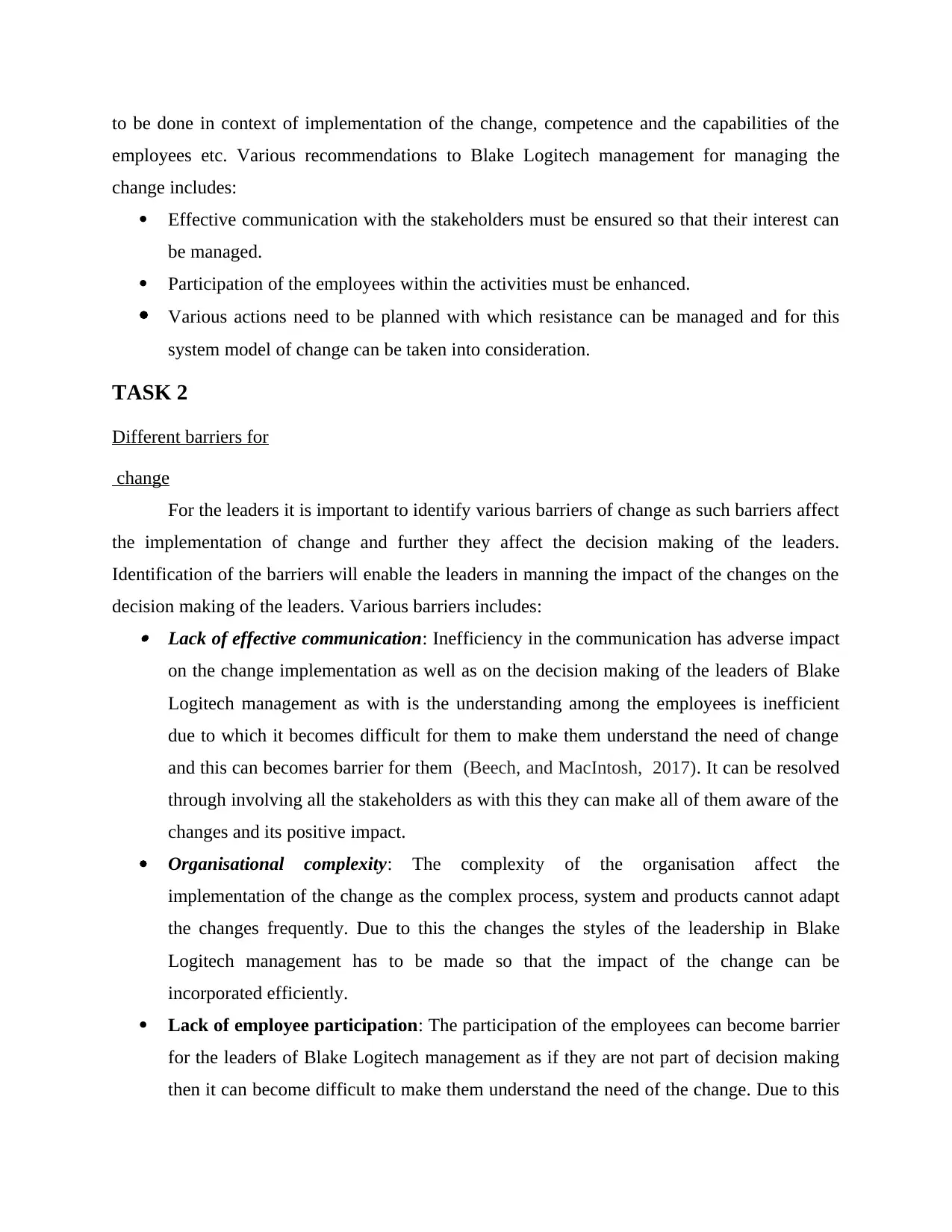
to be done in context of implementation of the change, competence and the capabilities of the
employees etc. Various recommendations to Blake Logitech management for managing the
change includes:
Effective communication with the stakeholders must be ensured so that their interest can
be managed.
Participation of the employees within the activities must be enhanced.
Various actions need to be planned with which resistance can be managed and for this
system model of change can be taken into consideration.
TASK 2
Different barriers for
change
For the leaders it is important to identify various barriers of change as such barriers affect
the implementation of change and further they affect the decision making of the leaders.
Identification of the barriers will enable the leaders in manning the impact of the changes on the
decision making of the leaders. Various barriers includes: Lack of effective communication: Inefficiency in the communication has adverse impact
on the change implementation as well as on the decision making of the leaders of Blake
Logitech management as with is the understanding among the employees is inefficient
due to which it becomes difficult for them to make them understand the need of change
and this can becomes barrier for them (Beech, and MacIntosh, 2017). It can be resolved
through involving all the stakeholders as with this they can make all of them aware of the
changes and its positive impact.
Organisational complexity: The complexity of the organisation affect the
implementation of the change as the complex process, system and products cannot adapt
the changes frequently. Due to this the changes the styles of the leadership in Blake
Logitech management has to be made so that the impact of the change can be
incorporated efficiently.
Lack of employee participation: The participation of the employees can become barrier
for the leaders of Blake Logitech management as if they are not part of decision making
then it can become difficult to make them understand the need of the change. Due to this
employees etc. Various recommendations to Blake Logitech management for managing the
change includes:
Effective communication with the stakeholders must be ensured so that their interest can
be managed.
Participation of the employees within the activities must be enhanced.
Various actions need to be planned with which resistance can be managed and for this
system model of change can be taken into consideration.
TASK 2
Different barriers for
change
For the leaders it is important to identify various barriers of change as such barriers affect
the implementation of change and further they affect the decision making of the leaders.
Identification of the barriers will enable the leaders in manning the impact of the changes on the
decision making of the leaders. Various barriers includes: Lack of effective communication: Inefficiency in the communication has adverse impact
on the change implementation as well as on the decision making of the leaders of Blake
Logitech management as with is the understanding among the employees is inefficient
due to which it becomes difficult for them to make them understand the need of change
and this can becomes barrier for them (Beech, and MacIntosh, 2017). It can be resolved
through involving all the stakeholders as with this they can make all of them aware of the
changes and its positive impact.
Organisational complexity: The complexity of the organisation affect the
implementation of the change as the complex process, system and products cannot adapt
the changes frequently. Due to this the changes the styles of the leadership in Blake
Logitech management has to be made so that the impact of the change can be
incorporated efficiently.
Lack of employee participation: The participation of the employees can become barrier
for the leaders of Blake Logitech management as if they are not part of decision making
then it can become difficult to make them understand the need of the change. Due to this
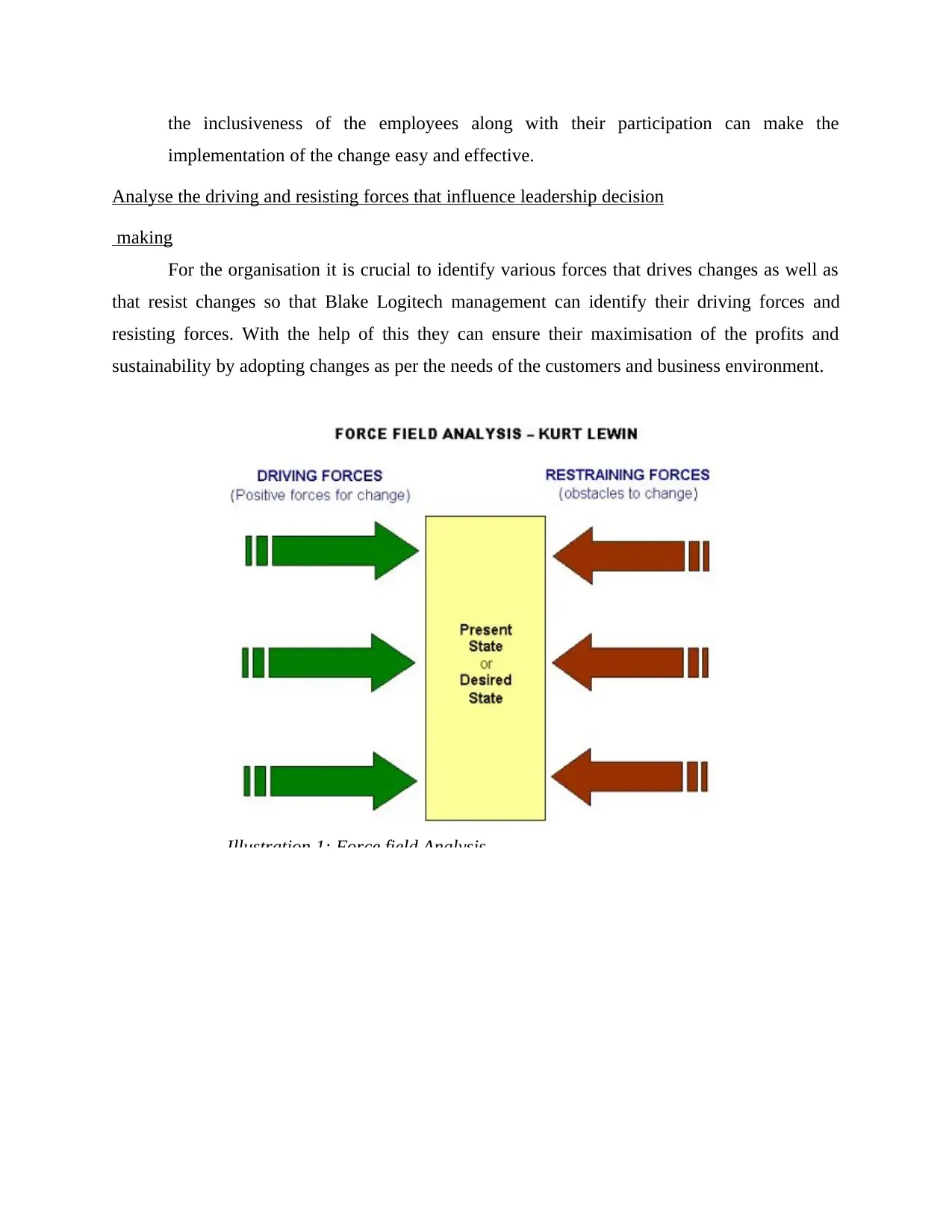
the inclusiveness of the employees along with their participation can make the
implementation of the change easy and effective.
Analyse the driving and resisting forces that influence leadership decision
making
For the organisation it is crucial to identify various forces that drives changes as well as
that resist changes so that Blake Logitech management can identify their driving forces and
resisting forces. With the help of this they can ensure their maximisation of the profits and
sustainability by adopting changes as per the needs of the customers and business environment.
Illustration 1: Force field Analysis
implementation of the change easy and effective.
Analyse the driving and resisting forces that influence leadership decision
making
For the organisation it is crucial to identify various forces that drives changes as well as
that resist changes so that Blake Logitech management can identify their driving forces and
resisting forces. With the help of this they can ensure their maximisation of the profits and
sustainability by adopting changes as per the needs of the customers and business environment.
Illustration 1: Force field Analysis
Secure Best Marks with AI Grader
Need help grading? Try our AI Grader for instant feedback on your assignments.
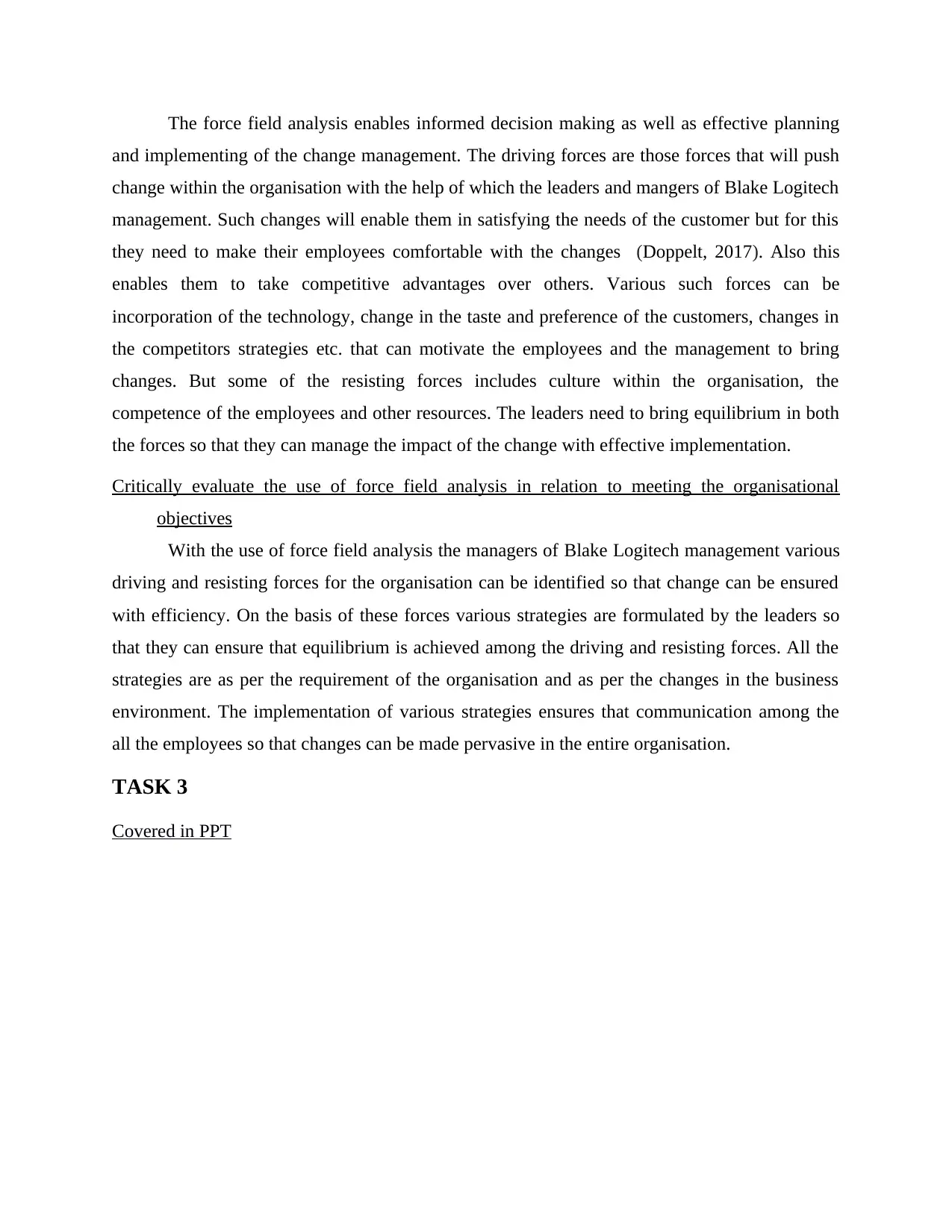
The force field analysis enables informed decision making as well as effective planning
and implementing of the change management. The driving forces are those forces that will push
change within the organisation with the help of which the leaders and mangers of Blake Logitech
management. Such changes will enable them in satisfying the needs of the customer but for this
they need to make their employees comfortable with the changes (Doppelt, 2017). Also this
enables them to take competitive advantages over others. Various such forces can be
incorporation of the technology, change in the taste and preference of the customers, changes in
the competitors strategies etc. that can motivate the employees and the management to bring
changes. But some of the resisting forces includes culture within the organisation, the
competence of the employees and other resources. The leaders need to bring equilibrium in both
the forces so that they can manage the impact of the change with effective implementation.
Critically evaluate the use of force field analysis in relation to meeting the organisational
objectives
With the use of force field analysis the managers of Blake Logitech management various
driving and resisting forces for the organisation can be identified so that change can be ensured
with efficiency. On the basis of these forces various strategies are formulated by the leaders so
that they can ensure that equilibrium is achieved among the driving and resisting forces. All the
strategies are as per the requirement of the organisation and as per the changes in the business
environment. The implementation of various strategies ensures that communication among the
all the employees so that changes can be made pervasive in the entire organisation.
TASK 3
Covered in PPT
and implementing of the change management. The driving forces are those forces that will push
change within the organisation with the help of which the leaders and mangers of Blake Logitech
management. Such changes will enable them in satisfying the needs of the customer but for this
they need to make their employees comfortable with the changes (Doppelt, 2017). Also this
enables them to take competitive advantages over others. Various such forces can be
incorporation of the technology, change in the taste and preference of the customers, changes in
the competitors strategies etc. that can motivate the employees and the management to bring
changes. But some of the resisting forces includes culture within the organisation, the
competence of the employees and other resources. The leaders need to bring equilibrium in both
the forces so that they can manage the impact of the change with effective implementation.
Critically evaluate the use of force field analysis in relation to meeting the organisational
objectives
With the use of force field analysis the managers of Blake Logitech management various
driving and resisting forces for the organisation can be identified so that change can be ensured
with efficiency. On the basis of these forces various strategies are formulated by the leaders so
that they can ensure that equilibrium is achieved among the driving and resisting forces. All the
strategies are as per the requirement of the organisation and as per the changes in the business
environment. The implementation of various strategies ensures that communication among the
all the employees so that changes can be made pervasive in the entire organisation.
TASK 3
Covered in PPT
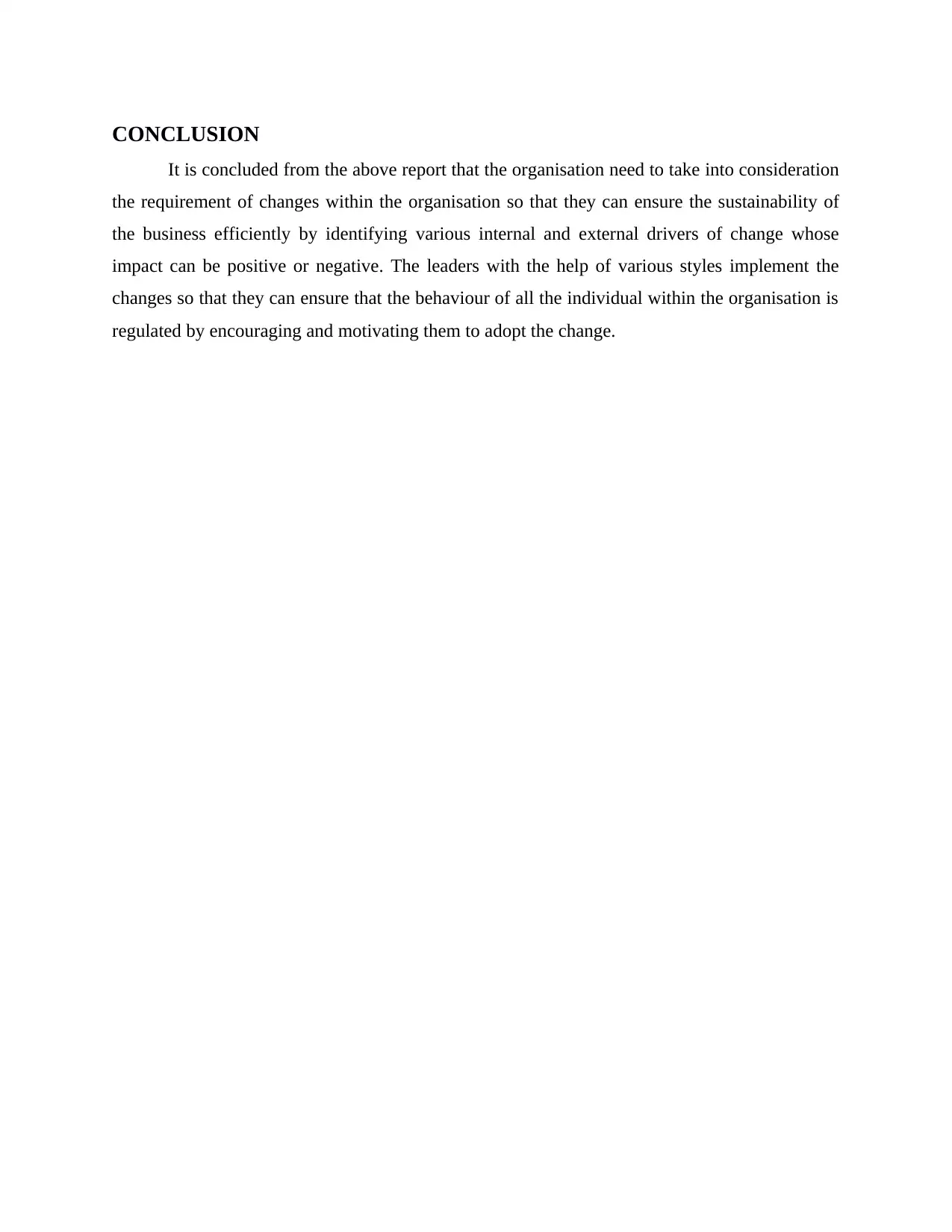
CONCLUSION
It is concluded from the above report that the organisation need to take into consideration
the requirement of changes within the organisation so that they can ensure the sustainability of
the business efficiently by identifying various internal and external drivers of change whose
impact can be positive or negative. The leaders with the help of various styles implement the
changes so that they can ensure that the behaviour of all the individual within the organisation is
regulated by encouraging and motivating them to adopt the change.
It is concluded from the above report that the organisation need to take into consideration
the requirement of changes within the organisation so that they can ensure the sustainability of
the business efficiently by identifying various internal and external drivers of change whose
impact can be positive or negative. The leaders with the help of various styles implement the
changes so that they can ensure that the behaviour of all the individual within the organisation is
regulated by encouraging and motivating them to adopt the change.
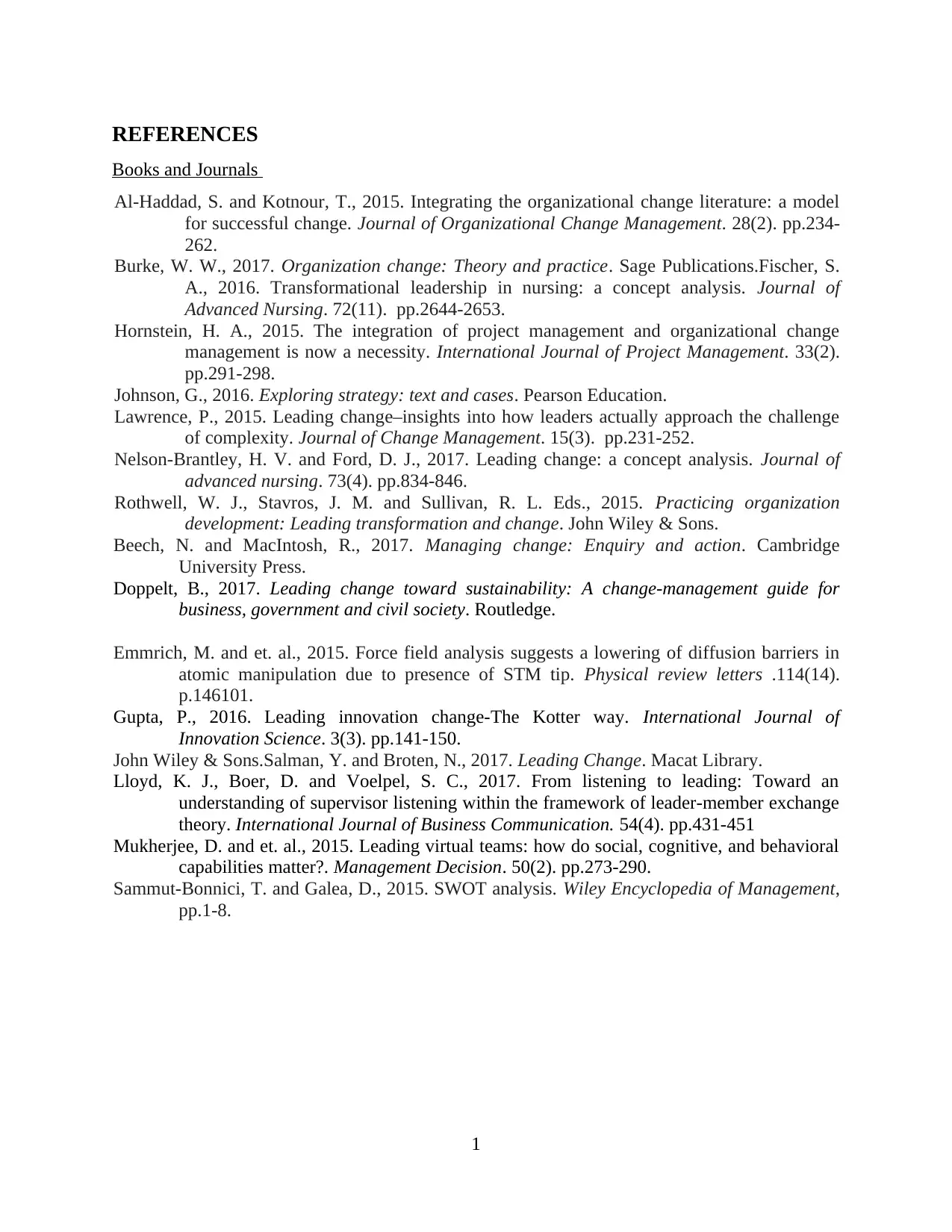
REFERENCES
Books and Journals
Al-Haddad, S. and Kotnour, T., 2015. Integrating the organizational change literature: a model
for successful change. Journal of Organizational Change Management. 28(2). pp.234-
262.
Burke, W. W., 2017. Organization change: Theory and practice. Sage Publications.Fischer, S.
A., 2016. Transformational leadership in nursing: a concept analysis. Journal of
Advanced Nursing. 72(11). pp.2644-2653.
Hornstein, H. A., 2015. The integration of project management and organizational change
management is now a necessity. International Journal of Project Management. 33(2).
pp.291-298.
Johnson, G., 2016. Exploring strategy: text and cases. Pearson Education.
Lawrence, P., 2015. Leading change–insights into how leaders actually approach the challenge
of complexity. Journal of Change Management. 15(3). pp.231-252.
Nelson‐Brantley, H. V. and Ford, D. J., 2017. Leading change: a concept analysis. Journal of
advanced nursing. 73(4). pp.834-846.
Rothwell, W. J., Stavros, J. M. and Sullivan, R. L. Eds., 2015. Practicing organization
development: Leading transformation and change. John Wiley & Sons.
Beech, N. and MacIntosh, R., 2017. Managing change: Enquiry and action. Cambridge
University Press.
Doppelt, B., 2017. Leading change toward sustainability: A change-management guide for
business, government and civil society. Routledge.
Emmrich, M. and et. al., 2015. Force field analysis suggests a lowering of diffusion barriers in
atomic manipulation due to presence of STM tip. Physical review letters .114(14).
p.146101.
Gupta, P., 2016. Leading innovation change-The Kotter way. International Journal of
Innovation Science. 3(3). pp.141-150.
John Wiley & Sons.Salman, Y. and Broten, N., 2017. Leading Change. Macat Library.
Lloyd, K. J., Boer, D. and Voelpel, S. C., 2017. From listening to leading: Toward an
understanding of supervisor listening within the framework of leader-member exchange
theory. International Journal of Business Communication. 54(4). pp.431-451
Mukherjee, D. and et. al., 2015. Leading virtual teams: how do social, cognitive, and behavioral
capabilities matter?. Management Decision. 50(2). pp.273-290.
Sammut‐Bonnici, T. and Galea, D., 2015. SWOT analysis. Wiley Encyclopedia of Management,
pp.1-8.
1
Books and Journals
Al-Haddad, S. and Kotnour, T., 2015. Integrating the organizational change literature: a model
for successful change. Journal of Organizational Change Management. 28(2). pp.234-
262.
Burke, W. W., 2017. Organization change: Theory and practice. Sage Publications.Fischer, S.
A., 2016. Transformational leadership in nursing: a concept analysis. Journal of
Advanced Nursing. 72(11). pp.2644-2653.
Hornstein, H. A., 2015. The integration of project management and organizational change
management is now a necessity. International Journal of Project Management. 33(2).
pp.291-298.
Johnson, G., 2016. Exploring strategy: text and cases. Pearson Education.
Lawrence, P., 2015. Leading change–insights into how leaders actually approach the challenge
of complexity. Journal of Change Management. 15(3). pp.231-252.
Nelson‐Brantley, H. V. and Ford, D. J., 2017. Leading change: a concept analysis. Journal of
advanced nursing. 73(4). pp.834-846.
Rothwell, W. J., Stavros, J. M. and Sullivan, R. L. Eds., 2015. Practicing organization
development: Leading transformation and change. John Wiley & Sons.
Beech, N. and MacIntosh, R., 2017. Managing change: Enquiry and action. Cambridge
University Press.
Doppelt, B., 2017. Leading change toward sustainability: A change-management guide for
business, government and civil society. Routledge.
Emmrich, M. and et. al., 2015. Force field analysis suggests a lowering of diffusion barriers in
atomic manipulation due to presence of STM tip. Physical review letters .114(14).
p.146101.
Gupta, P., 2016. Leading innovation change-The Kotter way. International Journal of
Innovation Science. 3(3). pp.141-150.
John Wiley & Sons.Salman, Y. and Broten, N., 2017. Leading Change. Macat Library.
Lloyd, K. J., Boer, D. and Voelpel, S. C., 2017. From listening to leading: Toward an
understanding of supervisor listening within the framework of leader-member exchange
theory. International Journal of Business Communication. 54(4). pp.431-451
Mukherjee, D. and et. al., 2015. Leading virtual teams: how do social, cognitive, and behavioral
capabilities matter?. Management Decision. 50(2). pp.273-290.
Sammut‐Bonnici, T. and Galea, D., 2015. SWOT analysis. Wiley Encyclopedia of Management,
pp.1-8.
1
1 out of 13
Related Documents
Your All-in-One AI-Powered Toolkit for Academic Success.
+13062052269
info@desklib.com
Available 24*7 on WhatsApp / Email
![[object Object]](/_next/static/media/star-bottom.7253800d.svg)
Unlock your academic potential
© 2024 | Zucol Services PVT LTD | All rights reserved.





